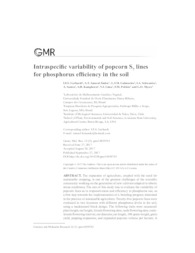Intraspecific variability of popcorn S7 lines for phosphorus efficiency in the soil.
Intraspecific variability of popcorn S7 lines for phosphorus efficiency in the soil.
Author(s): GERHARDT, I. F. S.; AMARAL JÚNIOR, A. T.; GUIMARAES, L. J. M.; SCHWANTES, I. A.; SANTOS, A.; KAMPHORST, S. H.; LIMA, V. J.; POBLETE, F. M.; MYERS, G. O.
Summary: The expansion of agriculture, coupled with the need for sustainable cropping, is one of the greatest challenges of the scientific community working on the generation of new cultivars adapted to abiotic stress conditions. The aim of this study was to evaluate the variability of popcorn lines as to responsiveness and efficiency in phosphorus use, as a first step towards the implementation of a breeding program interested in the practice of sustainable agriculture. Twenty-five popcorn lines were evaluated in two locations with different phosphorus levels in the soil, using a randomized block design. The following traits were measured: plant height, ear height, female flowering date, male flowering date, male-female flowering interval, ear diameter, ear length, 100-grain weight, grain yield, popping expansion, and expanded popcorn volume per hectare. A combined analysis of variance and test of means were performed, and the lines were classified as to their phosphorus use efficiency, according to their production performance in the different environments. The genetic diversity between the lines was estimated by Tocher?s and UPGMA clustering methods, using generalized Mahalanobis distance. Lines L59, P7, P2, P3, P4, P8, P10, P9, L66, L70, L69, and P5 were efficient and responsive, whereas lines L75, L80, L61, L77, L63, L65, P1, L54, L53, L88, and L71 were inefficient and nonresponsive. Genetic variability was greater in the environments with low phosphorus in the soil, suggesting that the selection pressure exerted in the stressing environment is a decisive factor to obtain a higher expression of variability.
Publication year: 2017
Types of publication: Journal article
Unit: Embrapa Maize & Sorghum
Observation
Some of Embrapa's publications are published as ePub files. To read them, use or download one of the following free software options to your computer or mobile device. Android: Google Play Books; IOS: iBooks; Windows and Linux: Calibre.
Access other publications
Access the Agricultural Research Database (BDPA) to consult Embrapa's full library collection and records.
Visit Embrapa Bookstore to purchase books and other publications sold by Embrapa.

